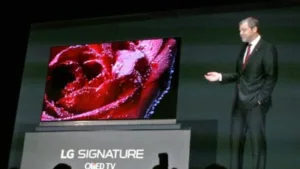One billion dollars worth of OLED TV sets were sold last year, seven times the sales in 2014, according to a recent IHS report. Ninety percent of that market belonged to LG, but Shin Hyun-jun, an analyst with LIG Investment & Securities Co., expects Samsung to enter the market in late 2017, according to a late-February story from South Korea’s Yonhap News Agency.

This increase in TV sales drove a 12% increase in light-emitting OLED materials last year, for a yearly total of 26,000kg, according to the latest issue of IHS’s OLED Materials Market Tracker. Revenues from these materials were $465 million, and IHS expects them to reach $1.8 billion in 2018.
Kihyun Kim, IHS Technology’s senior analysis for chemical materials research, said, “The market for small and mediium OLED displays is stable, and OLED TV shipments are increasing, which is supporting OLED light-emitting materials market growth. Shipments of organic light-emitting materials for WOLED are expected to increase with along with WOLED TV shipments, as more manufacturers are planning to adopt the technology. WOLED materials are expected to outstrip final-metal-mask red-green-blue (FMM RGB) materials in 2017 for the first time.”
That means that for the first time OLED TV will be the primary driver of OLED materials sales, not cell phones and tablets, and that change will be remarkably rapid — after years of not being rapid at all. FMM RGB materials took 82% of the market last year; WOLED will take 51% of shipments in 2017 and 55% in 2018, predicts IHS. Revenue growth for WOLED materials will be greater than shipment growth because WOLED materials remain more expensive than FMM RGB materials for now.
Samsung’s initial foray into OLED TV was forced by LG’s agressive leap into WOLED TV sets. Samsung used its FMM RGB technology, and quickly withdrew from the market, saying the technology was not yet ready for commercial involvement. In the last year, Samsung has ramped up its OLED TV develop program significantly. Initial reports indicated that Samsung was pursuing a WOLED approach generally similar to LG’s. More recently, “remorts” (more than a rumor but not quite a report) have indicated a parallel development program for FMM RGB TV panels, which could use some kind of hybrid approach.
OLED TV is also riding one of the overall TV market’s bright spots: 4K TV (all of LG’s 2016 OLED TVs are 4K). Half of 55″+ TV shipments were 4K, and even at screen sizes of 48″-50″, the 4K share was 30%, according to the latest IHS “TV Sets Market Tracker.”
For 2016, LG announced that its OLED TV offerings will consist of a number of sets in several families, rather than only. This marks the evolution of OLED TV into a product line-up appealing to a wider range of consumers at a wider range of price points. The strategy is being supported by the construction of a new advanced-generation panel fabrication facility.
At CES, David VanderWaal, marketing VP for LG Electronics USA, introduced the Signature, LG’s top-of-the-line 4K OLED TV set with high dynamic range and all-glass chassis. (Photo: Ken Werner)
At CES, LG’s top-of-the-line 4K UHD Premium sets were clearly “best in show.” With improving panel yields and significantly increased manufacturing capability, and with competition from Samsung just over the horizon, prices will continue to decline and will drive significantly increasing material, panel, and TV-set sales. Finally, OLED TV as a premium mass-market product is within sight. OLED TV is Real.
– Ken Werner

